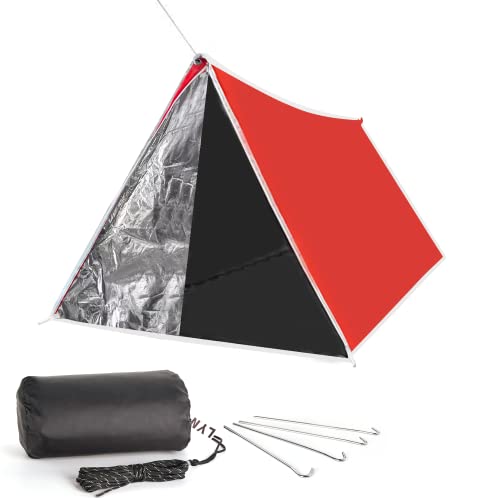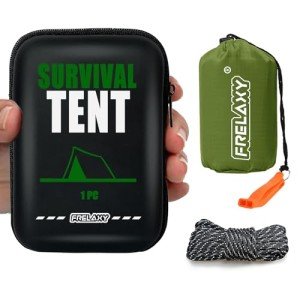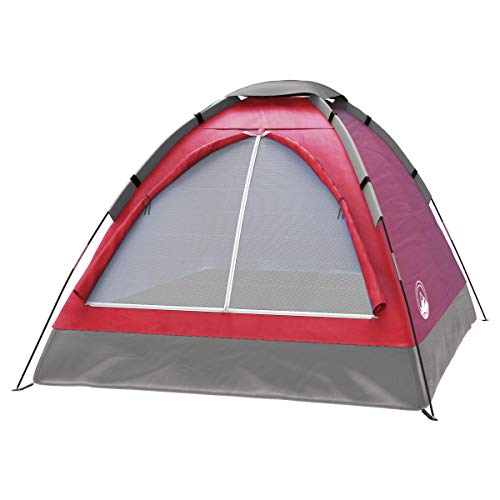In-Depth Review: Emergency Thermal Tent - Reflective Mylar Survival Shelter (XL Size, 8x3 ft)
When it comes to outdoor preparedness, shelter is one of the most critical items in any emergency or survival kit. The Emergency Thermal Tent—a reflective mylar survival shelter that claims to be waterproof, lightweight, and able to retain up to 90% of body heat—is marketed as an indispensable item for hikers, campers, preppers, and anyone putting together a bug-out bag. But how does it hold up in the wild?
After examining this tent's features, benefits, and limitations, I’ve found here.
Overview and Key Features
Let’s start with the basics. The Emergency Thermal Tent is made from thick, reflective mylar material, the same kind used by NASA in space blankets. It's designed as a tube tent, which means it creates an enclosed space open at both ends, offering protection from the wind and elements while retaining body heat. It measures 8 feet in length and 3 feet in width, large enough to fit two adults in a tight side-by-side position.
This tent is marketed primarily for emergencies, not long-term camping or heavy-duty wilderness expeditions. It’s ultralight—only a few ounces—and folds down small enough to easily fit into a glovebox, backpack, or survival kit. It’s a no-frills shelter designed to be there when you need it most.
What's Included?
-
1x XL mylar tent (8 x 3 feet)
-
1x nylon stuff sack
-
1x length of paracord for hanging
-
4x metal stakes or tie-downs (depending on the version purchased)
-
Basic setup instructions
Advantages
✅ Excellent Heat Retention
The mylar material reflects 90% of body heat, which can be lifesaving in a cold-weather emergency. Whether you're lost in the woods or stuck in your car during a snowstorm, the tent creates a pocket of warm air that drastically improves your chances of avoiding hypothermia. It also serves as an excellent windbreak.
✅ Lightweight and Compact
This shelter is ideal for ultralight backpackers and survivalists. At just a few ounces, its small packed size means you can toss it in a glove compartment, backpack, or emergency drawer without even noticing it's there. When rolled up, it takes up less space than a soda can.
✅ Fits Two Adults (Cozy Fit)
The 8x3 ft size is adequate for two people lying side-by-side. It will be snug—especially if both people are tall or broad—but it's doable. Having two people inside also helps generate and retain more body heat.
✅ Waterproof and Windproof
While mylar isn't breathable, it's 100% waterproof and protects well against rain and snow. As a temporary shelter, it keeps you and your gear dry. When staked down properly or tied between trees using the paracord, it holds up reasonably well against moderate wind.
✅ Easy Setup
You can quickly set it up between two trees using the included paracord or lay it directly on the ground as a bivy sack. The setup process takes less than five minutes, even for someone with no camping experience.
✅ Cost-Effective
This shelter delivers incredible value for the price (often under $20). It's an affordable way to boost your safety margin on any trip outdoors or in an emergency.
Disadvantages
❌ Not Meant for Long-Term Use
This is a one-time or limited-use shelter. Mylar is relatively fragile compared to traditional tent fabrics. It's prone to tearing, especially if snagged on branches or sharp rocks or if you over-tension it while setting up.
❌ Condensation Build-Up
Because the material is non-breathable, condensation will occur inside the tent, particularly in humid or cold conditions. This can make things damp and slightly uncomfortable, though not dangerous in short-term use.
❌ Tight Fit for Two People
While it technically fits two people, don’t expect comfort. There's little wiggle room, and the fit is more appropriate for emergencies than leisurely camping. This could be an issue if you're claustrophobic or need more space.
❌ No Ground Insulation
There is no built-in ground insulation. Heat loss through conduction is a concern if it is used on snow, wet soil, or cold rock. To improve comfort and warmth, it’s best to use it with an insulating pad, dry leaves, or even clothing underneath you.
❌ Noise Factor
Mylar is loud. It crinkles with every move, which can be annoying during the night. If you’re a light sleeper, be prepared for some rustling.
Common Questions
🔹 Is this tent reusable?
Yes, but with caution. While the tent is marketed as reusable, it depends on how gently it's used and repacked. If you avoid punctures and tears and fold it carefully, you can reuse it a few times. However, it’s not designed for long-term repeated use like traditional tents.
🔹 How do you set it up?
The simplest way is to run the included paracord between two trees and drape the tent over it to form an A-frame shape. Stake the corners or anchor them with rocks. By crawling inside and sealing one end, it can also be used as a sleeping bag-style bivy sack.
🔹 Will it work in heavy rain or snow?
Yes, mylar is waterproof, so it will shed water effectively. However, it can sag under heavy snow, and pooling water underneath can become an issue. Use a tarp underneath or choose elevated, dry ground when possible.
🔹 Can it be used in hot climates?
Sort of. The reflective surface also reflects sunlight, which helps prevent overheating in desert environments. But since the material doesn't breathe, it can get uncomfortably hot if you're inside during warm weather. It's more effective as a shade shelter than a tent in hot climates.
🔹 Can it be used as a ground cover or blanket?
Yes, absolutely. It’s versatile—you can lay it out as a ground tarp, wrap it around yourself as a heat blanket, or even use it as a signal reflector in a survival situation.
Best Uses
-
Emergency shelter in cars (e.g., snowstorm survival)
-
Bug-out bags or go-bags
-
Backcountry emergencies
-
Day hikes or summit kits
-
Backpacking backup shelter
-
Camping in unpredictable weather zones
-
Winter hiking or snowshoeing backup
Final Thoughts
The Emergency Thermal Tent is essential for anyone who spends time outdoors or wants to be ready for emergencies. It won’t replace a proper four-season tent, but that’s not its job. As a last-resort, lightweight, emergency-use shelter, it performs admirably. It’s compact, effective, and inexpensive, offering peace of mind when you're miles from civilization or caught in unexpected weather.
Sure, it has limitations—especially in terms of durability and comfort—but those are fair trade-offs for something that could literally save your life in an emergency. Its portability, affordability, and heat retention capabilities make it a smart addition to any preparedness kit.
Final Rating: 4.5 out of 5 stars ⭐⭐⭐⭐✰
Pros:
-
Great heat retention
-
Super lightweight and portable
-
Affordable
-
Easy to set up
-
Waterproof and windproof
Cons:
-
Not breathable (condensation)
-
Fragile with repeated use
-
Tight for two people
-
Crinkly/noisy material
Recommendation:
Buy one for your car, hiking pack, and emergency supply bin. It might be the best $20 you ever spend.






